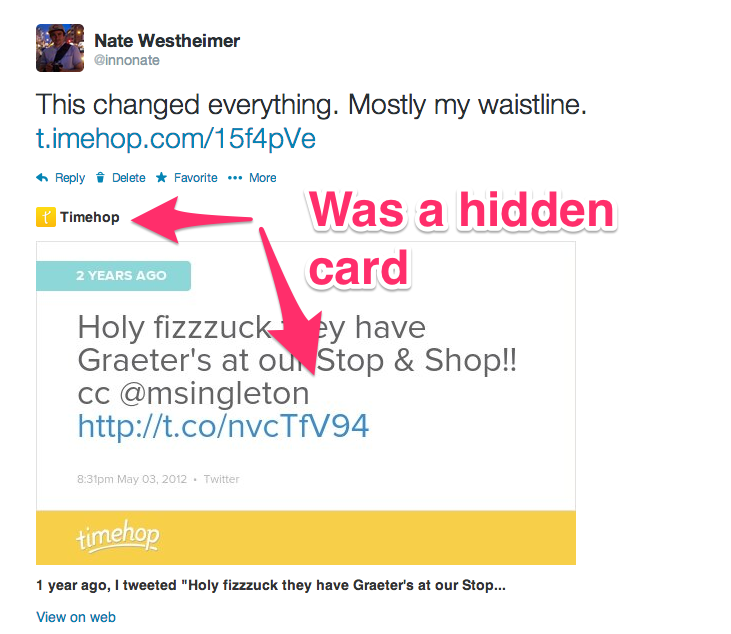Twitter's Card Problem: The Photo Upload Anti-Pattern
There is little doubt that "the card" will become a critical unit in the future of the World Wide Web.
App developers and marketers alike are climbing over each other to update their campaigns and websites to live in a "card" world, while startups like Wildcard are building out the much needed plumbing to help people take advantage of this new design pattern and extend it beyond Twitter's walls.
However, I see a major obstacle standing in the way of "card" adoption, and that's Twitter's separate, favored-nation treatment of photo uploads on their system.
Whereas Twitter only show users a small icon in their streams when a tweet contains a normal "card", Twitter prominently shows when a user (or a brand, or an app developer) uploads a photo. Here's an example from my Twitter stream this morning:

It is completely understandable why Twitter would want to favor user photos -- if your friend took and is sharing a photo, it's likely far more relevant than a visual summary of an article a friend is linking to. Screen space is in short supply, and so Twitter has to decide what to favor.
But, the problem is that this design decision is encouraging a nasty anti-pattern that threatens the future of cards and therefore threatens the future of a more usable, enjoyable Internet.
Because Twitter is so clearly favoriting directly uploaded photos over their own "photo card" format, app developers and publishers are skipping this new open standard and reverting back to direct uploads.
Take Business Insider, as an example. There is a very clear standard for marking up news articles with big images using Twitter Cards. It's appropriately called "Summary Card with Large Image."
However, being the clever company that Business Insider is, it chooses instead to upload the image used in the article, thereby greatly increasing the chances that its followers will actually see the post and click-through. And, while Twitter's photo upload API was clearly meant for users' real pictures, you can't blame Business Insider for "hacking" the use-case and getting more views.
[caption id="" align="alignnone" width="665.0"] Business Insider didn't use cards, it used a simple photo upload[/caption]
Business Insider didn't use cards, it used a simple photo upload[/caption]
While Business Insider may be one of the more aggressive publishers out there, high-growth, smart startups are also entering the fray, and in some cases are going back in Internet time, going from use of cards to cleverly generated images that look like cards.
Take our good friends at Timehop as an example. Last year they were an early adopter of Twitter's Cards standards, beautifully showing you a summary of your past moment right in your Twitter feed -- if you opened up the card.

Today, however, Timehop seems to have abandoned Twitter Cards, and has joined folks like Business Insider by simply doing a direct upload of their card as a rendered out image -- as if they were a user sharing a photo with friends.

As a user, fan and friend of Timehop (and a very tiny, indirect investor)*, I'm glad they've gone this new route to make sure I see more interesting Timehop content in my Twitter feed.
In fact, as soon as I saw what Timehop was doing I started building a prototype of how Picturelife could do the same thing, instead of using the aforementioned Twitter Photo cards. As with Business Insider, you definitely can't blame the publishers and developers for exploiting a design decision Twitter has made.
However, ultimately steering people away from open standards like "cards" is bad for the Internet and will attract as many bad actors as good actors using the system. It's like what happened with emails in the late 90s and early 2000s. Before best practices followed by Outlook and other popular email clients, web designers just started emailing full-text images of formatted text, eschewing HTML, machine readable text, and open standards for what "just worked."
Today, because email clients and spam filters have gotten better, and because search has become such an important part of email, this anti-pattern has reversed and sending an all-image email is left to the fake Viagra spammers of the world.
The good news is Twitter can get out in front of this quickly and reverse the trend.
The right thing for Twitter to do is not block the Business Insiders, Timehops, and Picturelife's of the world from using their media upload endpoint, it's to stop favoring media uploads over Twitter Cards in their interfaces.
My solution for Twitter would be rather simple: Twitter should invest in generating a quality score for all cards and direct uploads, and smartly obfuscate cards and photos from uploaders with low quality scores, and prominently display full cards and uploads from users, publishers, and developers with higher quality scores.
Twitter can reverse this anti-pattern if they act now. Until then, more of us will just start "hacking" Twitter and upload our cards as static photos.
Disclosure: Wildcard's CEO, Jordan Cooper, is a Partner at Lerer Ventures, an investor in Picturelife. Nate Westheimer is an investor in TechStars, which is an investor in Timehop.